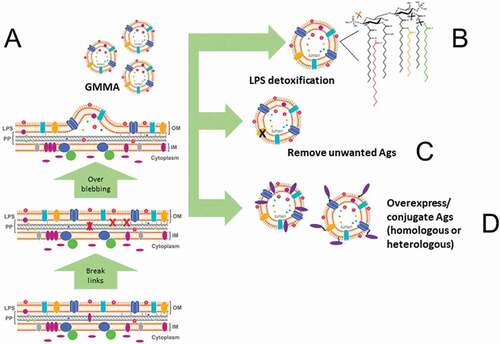Figures & data
Figure 1. The GMMA technology. The features of GMMA production are summarized in this diagram. Genetic manipulations are introduced in the bacterial strain used as source of GMMA with the aim to: (A) Improve the natural capacity of the Gram-negative bacterium to release outer membrane blebs. (B) Reduce the capacity of LPS to stimulate a reactogenic response upon GMMA injection in the body. (C) Remove antigens (Ags) that can be considered detrimental for the effectiveness/safety of the GMMA-based vaccine. (D) Overexpress antigen candidates that can improve the protective efficacy of the GMMA-based vaccine or are necessary for its design. Once GMMA are obtained, in addition to genetic manipulation of the bacterial cells, antigens can be chemically conjugated to GMMA with the same aim to generate GMMA carrying antigen candidates for the protective efficacy of the GMMA-based vaccine.

Figure 2. Immunological mechanisms of GMMA immunogenicity to be investigated with high priority. Diagram of the immunological mechanisms that should be carefully investigated to unveil the mode of action of GMMA immunogenicity. Innate immunity (left hand side): (1) Upon injection of GMMA, innate immune responses are triggered by direct or indirect activation of different immune cell types, which in turn promote the production of different factors (mainly cytokines) affecting the type and extent of the innate immune response. (2) TLRs are critical receptors for the triggering of innate immune responses and GMMA can have an active role on activating cells via these receptors due to their content of lipoproteins/peptidoglycan and LPS, that are TLR2 and TLR4 agonists respectively. Adaptive immunity (right hand side): (3) Antigen presentation by DCs induces activation of antigen-specific T cells, that in turn activate cognate B cells while presenting antigen to activated T cells. (4) Inside the germinal center, activated antigen-specific B cells encounter the antigen again presented by FDCs, undergoing to an additional and critical stimulation. (5) FDC-stimulated antigen-specific B cells interact with cognate Tfh cells to receive the stimulation which leads to complete the differentiation in antibody-secreting plasma cells or memory B cells. (6) This journey results in the production of antibodies that are functional and persistent inside the body, and in the establishment of the memory B cell compartment. (7) GMMA that arrive to the lymphoid organs via afferent lymphatics can be captured by SCSMs and delivered to antigen-specific B cells. (8) In addition, Mo-DCs, that can develop upon triggering of innate immune responses, may promote Tfh differentiation.

